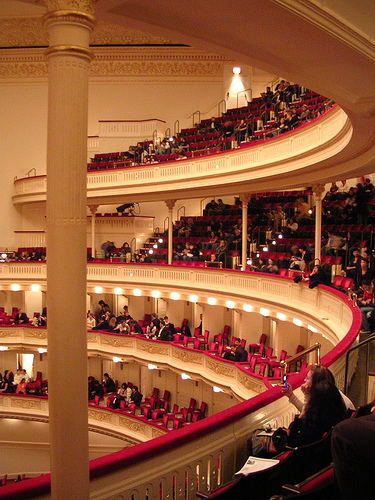An Evening of the Past, In A Place of the Future?
18 02 2008Thursday night I went to the Tibet Benefit Concert at Carnegie Hall, hosted by Philip Glass. It was a great musical experience, featuring Sufjan Stevens, Marisa Monte and Band of Horses and many, many others. The performances were incredible, with Sufjan Stevens’ reworking of “The Star-Spangled Banner” and Nawang Khechog, a Tibetan multi-instrumentalist, doing “The Last Stand of the Wild Yaks” with drums and a mini-didgeridoo. There was also Ashley MacIsaac and Phamie Gow playing a very catchy piece on fiddle and harp, respectively. To bring down the house, they had Ray Davies of Kinks’ fame play two classics, “Lola” and “All of the Day and All of the Night”.
It was a great night for such a prestigious and historical venue like Carnegie Hall, except I was decidedly unfulfilled. The artists were still making the speakers pop when they plugged and unplugged their instruments, and numerous times the performers had to ask a tech to help them get sound out of their amps. All the technical difficulties got me thinking about how just because society might have fancy new phones and computers, the art of performance hasn’t really come as far as it should in the past twenty years.
The experience got me thinking about technology and performances. I feel that even though Carnegie Hall is old, that doesn’t necessarily mean it must be old-fashioned. I started thinking about systems, and how a system could be created to have a multi-faceted, modifiable and seamless system in place to bring performance and a place like Carnegie Hall into the future. Here are a few different ideas as to how something like that could be implemented:
Realistic Systems:
1. Wireless Jack Packs – Each performer would come into a venue and receive a small wireless pack, maybe about 3″ x 6″x 1″. It would have a combination XLR and 1/4″ instrument jack for plugging in almost anything, with a special switch that would lock the cable in, much like the device used with XLR jacks nowadays. That way, once that button was pressed, the wireless pack would shut off in a way that would not create annoying, speaker-damaging pops and crackles. Each pack would come with it’s own matching male connector, in order to plug into any amp or speaker. In addition, if a musician or performer wanted to be routed to the sound system, either the male connector could just be plugged in, or the pack could have a switch to change to a direct line to the PA. Of course, the system would also have to include different lengths of cords to go from instrument to the wireless pack.
2 . Wireless Connectors – Since there is already technology small enough, the venue could provide an array of wireless connectors and microphones, small enough to just plug right in, or stick to the instrument. Each would have to be a different type, like a stick-on resonant microphone for violins, cellos and most stringed instruments, while having a clip-on condenser for wind instruments like saxophones and trumpets. To address the popping of inserting and removing mics and cables, a mechanism could be designed to alert the wireless system of an impending removal or insertion. Something like a twist action to affix the microphone, therefore integrating both application and powering motions into one. For the resonant mic, a twist could be to get the mic to stick with suction. For the clip-on, it could be activated by the clip being opened, or it could come folded a certain way, and activated by unfolding after the mic has been affixed to the instrument. This solution would eliminate extra wires and create the most invisible system, however there could be problems with the actually attachment of microphones and connectors, depending on the dimensions of the instruments.
Dream Systems:
1. Wireless Standard – If all the instrument companies, like the computer manufacturers, agreed upon a wireless standard that could have transmitters built into the instruments, or at least the amps, creating an easy and innovative system. This system could also work in tandem with PA systems, making it incredibly easy to connect to both. In addition, this would eliminate all pop and crackle problems. Guitarists, bassists, violinists alike could all go between amps as easily as pressing a button or two, to sync the two up.
2. An Entire System Overhaul – We’re talking microphones, speakers, and monitoring systems rebuilt from the ground up. For years now researchers have been trying to create microphones that actually take in sound the way human ears do, which could significantly improve sound gathering techniques. Of course, speaker would also have to be created that could sufficiently reproduce this sound. One technology, called directional audio, could beam the whole performance to each and every person, without worrying about echo and acoustics. And the in-between connections could be wireless as well, serving up music the way the twenty-first century should.
All these are ideas for the future of performance, specifically musical performance. What ideas do you have for the video aspects of performance?
A few interesting links:
New Technique for Killing Viruses



 RSS 2.0
RSS 2.0